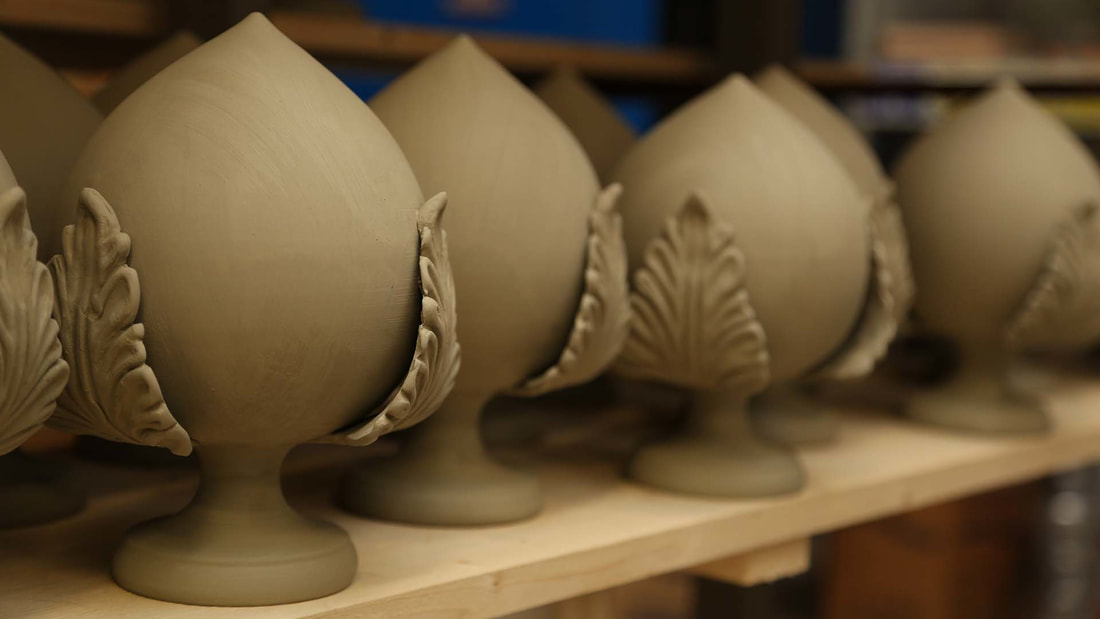 When Voyaging throughout Puglia, you might start seeing colorful ceramic flower buds or pine cones displayed on balconies, lined up on staircases or in gardens. You will see them for sale in gift shops and ceramic shops in most towns you visit. But what are they? Do they have a spiritual meaning?  They are called Pumi di Grottaglie, primarily made in the town of Grottaglie (a hub of ceramic production). They represent flower buds (or rose hips) with their pointed bud-shaped design with acanthus leaves surrounding the base. The form can also look more like pine cones, with many points surrounding its form. Pumi are made in all sorts of colorful glazes--even metallic gold. Others will be painted in complex floral designs popular in Mezzogiorno (the South). Still others can be decorated with a lacework of holes, to be used as candle holders, lamps or incense burners.  The term pumo comes from the Latin pomum (fruit) and is said to have its roots in honoring the pagan goddess Pomona, deity of fruit, olives and grapes. In some areas of Puglia these ceramics are called Pumo de fiure (flower bud). They represent life about to burst open and flourish--symbols of abundance of the land and of birth itself, but also of prosperity, chastity, immortality and resurrection. In common use, they are put on balconies and into homes to ward off evil and Il Malocchio, or the evil eye. If you're ever in Puglia, bring a Pumo back to keep your home safe. With the multitude of colors and styles to choose from, you will certainly find one (or several) to compliment your decor. In the least, bring home a pair to attach to your own balcony or front steps to keep away the evil spirits... --GVI A ceramic artisan showing how a pulo is thrown on the pottery wheel. A wonderful short film called Il Pumo, in which a young displaced Pugliese
decides to return to the land of his forefathers after being inspired by the story and his purchase of a Pumo.
4 Comments
5/6/2018 11:55:20 pm
One of the reasons why it is a dream for me to go in Italy is because of the ceramic products that were made centuries ago. Collectors will understand my desire since they also feel the same way. It would be an honor for me to have alt least one of the Pumi di Grottaglie that are being sold there! But there were modern ceramic products and being sold on a lower price. If you have a limited budget, you can settle on that.
Reply
Jerry Finzi
5/9/2018 08:50:16 am
I agree about the ceramics in Italy. Both my son (almost 15 now) and myself are very interested in ceramics and have both spent time on the throwing wheel with clay. It's a wonderful medium. If you get to Italy, don't forget to stop by the ceramics shops in Vietri sul Mare near Salerno on the Amalfi Coast. There are a cluster of artisans there as well as the Solimene Ceramics factory... its building is a modern work of art of its own. We regret not bringing back more ceramics and will dedicate two carry-ons to bringing some back after our next Voyage. And in the north, check out Deruta, Orvieto and Gubbio (Umbria), Faenza in the Emilia Romagna, and in the Veneto check out the small town of Nove where they have many ceramics factories. .... But, you might also look into antiques flea markets for those older ceramics. Have fun collecting! (We've found a U.S. source for Solimene at good prices and are collecting their chicken and pig patterns.)
Reply
dganit gur
9/16/2019 05:40:26 am
Reply
Jerry Finzi
9/20/2019 01:54:49 pm
Try this... a map of ceramics studios in Grottaglie: http://www.grandvoyageitaly.com/style/good-luck-ceramics-the-pumi-and-pigne-of-puglia
Reply
Leave a Reply. |
On Amazon:
|














 RSS Feed
RSS Feed
